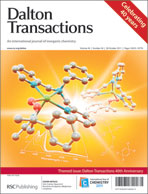The macrocycle 1,4,7-trithiacyclononane (ttcn) reacts with [(η5-Ind)Mo(CO)2(NCMe)2]+ (or [(η5-Ind)Mo(CO)2(κ2-dme)]+) to give [(η3-Ind)Mo(CO)2(κ3-ttcn)]+ as the BF4− salt (1), but its reaction with [(η5-Ind)Mo(CO)2(C3H6)(FBF3)] affords the C–S bond cleavage product [(η5-Ind)Mo(CO)(κ3-1,4,7-trithiaheptanate)]BF4 (6), which has been characterised by X-ray crystallography (Ind = C9H7, indenyl). In contrast to ttcn, the macrocycles 1,3,5-trithiane (tt) and 1,4,7,10-tetrathiacyclododecane (ttcd) fail to induce changes in the coordination mode of indenyl: tt and ttcd react with [(η5-Ind)Mo(CO)2(NCMe)2]+ (or [(η5-Ind)Mo(CO)2(κ2-dme)]+) to give [(η5-Ind)Mo(CO)2(κ2-tt)]+ (2), characterised by X-ray crystallography, and [(η5-Ind)Mo(CO)2(κ2-ttcd)]+ (3), respectively. The cyclopentadienyl (Cp = C5H5) analogues [(η5-CpMo(CO)2(κ2-tt)]+ (4) and [(η5-CpMo(CO)2(κ2-ttcn)]+ (5) have also been synthesised and 5 characterised by X-ray crystallography. DFT calculations showed that the η5-Ind/Cp coordination mode is always the most stable. However, a molecular dynamics study of the macrocycles conformations revealed that the major conformer of ttcn was a chair, which favoured κ3 coordination. As indenyl complexes undergo slippage with a small barrier (<10 kcal mol−1), the kinetically preferred species [(η3-Ind)Mo(CO)2(κ3-ttcn)]+ (1) is the observed one. The conversion to 6 proceeds stepwise, with loss of ethylene followed by loss of CO, as calculated by DFT, with a barrier of 38.7 kcal mol−1, consistent with the slow uncatalysed reaction.
![Graphical abstract: Indenyl ring slippage in crown thioether complexes [IndMo(CO)2L]+ and C–S activation of trithiacyclononane: Experimental and theoretical studies](/en/Image/Get?imageInfo.ImageType=GA&imageInfo.ImageIdentifier.ManuscriptID=C1DT10607D&imageInfo.ImageIdentifier.Year=2011)

 Please wait while we load your content...
Please wait while we load your content...